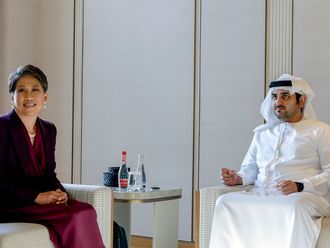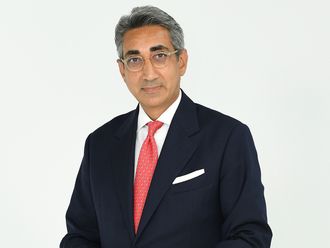
Dubai: Bank of Baroda, one of the leading Indian public sector banks and the lone Indian bank that has full service banking operations in the UAE is working on a strategy to rebalance its balance sheet with the objective of diversifying its loan exposures and income streams, Ranjan Dhawan, Managing Director and CEO told Gulf News in and Interview.
Historically the bank had high level of exposure to India’s corporate sector which made its asset quality highly vulnerable to the overall performance of the economy and ultimately the performance of the corporate sector.
“We have been a corporate focused bank for a very long time. Over a period of time we have realised that our corporate focus is skewing the risk in one direction. For example if there is a major economic downturn, it means our exposures are disproportionately susceptible to higher risks,” said Dhawan.
Most of the leading public sector banks in India face the problem of concentration of exposures to the corporate sector. Thanks to the ongoing efforts, BoB has a relatively diversified loan book, which has protected it from sharper deterioration than peers.
Higher slippages in the December quarter saw BoB’s gross non-performing asset ratio rising to 3.85 per cent, while restructured assets stood at 5.9 per cent of credit. Despite the weak performance in the quarter, the bank still has an advantage over peers in terms of a well-diversified book, healthy capital adequacy, provision coverage ratio, and current and savings account profile.
“Our current retail lending constitutes only about 12 per cent of out balance sheet. Over a period of time, we want to take to more than 20 per cent with the objective of de-risking the balance sheet from concentration,” said Dhawan.
Retail is clearly emerging an area of focus for BoB. “We are focusing more on retail customers by being more customer-focused. We have created huge retail banking capacities across our branch network; in addition we have nearly 60 loan factories focused on retail lending. Over a period of time we had become inactive in retail loans because of our focus on corporate loans and trade finance. We are now reorienting our staff to increase the share of retail loans in out books,” he said.
Leverage retail strengths
As part of the increased retail focus the bank is investing heavily in retail infrastructure such as ATMs, cheque deposit machines and electronic service delivery channels. “We have introduced the e-lobby concept where most of the retail banking transactions could be done through electronic channels ranging from ATMs, deposit machines and internet kiosks. We are looking at the possibility of adapting this concept for our UAE operations,” Dhawan said.
On the liability side of the business too, BoB wants to leverage its retail strengths. “There is a conscious effort to improve the CASA [current and savings account] component of our funding. Last year it was about 29 per cent and this year we expect to close above 33 per cent for the next year we are aiming to improve our CASA deposits to above 35 per cent,” he said.
BoB’s operational performance was healthy until the third quarter of 2015 wherein asset quality pressure, falling business traction and margins impacted its performance. In the third quarter the bank’s net profit tumbled 62 per cent due to one-time income tax payment of Rs4.1 billion (Dh236 million) as well as worsening NPA levels. Dhawan expects the NPA levels to remain elevated for the next couple of quarters before it began subsiding.
“As far as NPAs and restructured book is concerned, there would be a continuing pressure for a few more quarters. The sentiment in the market is very good; there is no doubt about it. I feel that FY15-FY16 should be much better,” said Dhawan
The International Monetary Fund (IMF) and the World Bank have projected India’s economy to grow by about 7.5 per cent this year. Credit rating agency Moody’s recently revised upwards the outlook to positive, from stable, for 12 state-owned banks and financial institutions including BoB. Dhawan sees the loan demand across all sectors is expected to pick up during the course of this year.
Although the banking sector as a whole is expected to face some amount of margin compression as the Reserve Bank of India (RBI) is likely to cut interest rates further. Dhawan said while he expected more rate cuts to follow, it will not impact BoB’s net interest margins.
Dhawan said the bank is comfortable on capital adequacy front. While it received fresh capital infusion from the government, the bank has the option to raise funds from the public markets. The government has already decided to bring its stake holding in public sector banks down to 52 per cent from the current norm of 58 per cent. Many banks, including BoB have the option to tap the market to raise capital.











